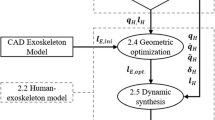Abstract
The article describes the synthesis module of design solutions for passive and active exoskeletons, taking into account the anthropometric parameters of the operator, the requirements and limitations imposed on the exoskeleton. Exoskeletons, presented on the market of their functional-parametric structure and technical characteristics, are investigated. The method of generating design solutions is considered by the example of an exoskeleton. An algorithm has been developed for the operator upper and lower extremities exoskeleton assembly synthesis, taking into account the anthropometric characteristics, requirements, and limitations of the exoskeleton, and also developed a system prototype for generating the assembly of the exoskeleton with regard to the anthropometric characteristics. The system for generating assemblies of different types of exoskeletons makes it easy to adapt to emerging markets and select the most suitable model taking into account various parameters.
Access this chapter
Tax calculation will be finalised at checkout
Purchases are for personal use only
Similar content being viewed by others
References
Schiele, A.: Fundamentals of Ergonomic Exoskeleton Robots. TU Delft, Delft University of Technology, Chicago (2008)
Munoz, L.: Ergonomics in the Industry 4.0: Exoskeletons (2017)
Näf, M., Junius, K., Rossini, M., Rodriguez-Guerrero, C., Vanderborght, B., Lefeber, D.: Misalignment compensation as a way to ensure full human-exoskeleton kinematic compatibility: state of the art and evaluation. Appl. Mech. Rev. 70, 050802 (2019). https://doi.org/10.1115/1.4042523
Louie, D., Eng, J.: Powered robotic exoskeletons in post-stroke rehabilitation of gait: a scoping review. J. NeuroEng. Rehabil. 13, 53 (2016)
Yang, K., Fei Jiang, Q., Lai Wang, X., Wu Chen, Y., Yan Ma, X.: Structural design and modal analysis of exoskeleton robot for rehabilitation of lower limb. J. Phys. Conf. Ser. 1087, 062004 (2018). https://doi.org/10.1088/1742-6596/1087/6/062004
Long, Y., Du, Z., Wang, W., Dong, W.: Development of a wearable exoskeleton rehabilitation system based on hybrid control mode. Int. J. Adv. Robot. Syst. 13 (2016). https://doi.org/10.1177/1729881416664847
Nacy, S., Hussein, N., Abdallh, M.M.M.: A review of lower limb exoskeletons. Innovative Syst. Des. Eng. 7, 1 (2016)
Frumento, Ch., Messier, E., Montero, V.: History and future of rehabilitation robotics (2010). https://web.wpi.edu/Pubs/E-project/Available/E-project-031010-112312/unrestricted/HRRIQP_Final.pdf. Accessed 14 Mar 2019
Villoslada, A., Rivera, C., Escudero, N., Martín, F., Blanco, D., Moreno, L.: Hand exo-muscular system for assisting astronauts during extravehicular activities. Soft Robot. 6, 21–37 (2018). https://doi.org/10.1089/soro.2018.0020
Servo control facts. http://www.baldor.com/pdf/manuals/1205-394.pdf. Accessed 27 Apr 2018
Prabhakaran, A., Ghosal, A.: A survey on static modeling of miniaturized pneumatic artificial muscles with new model and experimental results. Appl. Mech. Rev. 70, 040802 (2018). https://doi.org/10.1115/1.4041660
A great combination: pneumatic actuator, pneumatic timer, pneumatic valves, and pneumatic indicators. http://www.ekci.com/a-great-combination-pneumatic-actuator-timer-valves-and-indicators-ezp-69.html. Accessed 14 Apr 2019
Cecilia Villa-Parra, A., Delisle Rodriguez, D., Botelho, Th., Villarejo Mayor, J., Delis, A., Carelli, R., Frizera, A., Freire Bastos, T.: Control of a robotic knee exoskeleton for assistance and rehabilitation based on motion intention from sEMG. Res. Biomed. Eng. 34 (2018). https://doi.org/10.1590/2446-4740.07417
Folgheraiter, M., Jordan, M., Straube, S., Seeland, A., Kyoung Kim, S., Kirchner, E.: Measuring the Improvement of the interaction comfort of a wearable exoskeleton: a multi-modal control mechanism based on force measurement and movement prediction. Int. J. Soc. Robot. 4, 285–302 (2012). https://doi.org/10.1007/s12369-012-0147-x
Curtis, S., Kobetic, R., Bulea, T.C., et al.: Sensor-based hip control with hybrid neuroprosthesis for walking in paraplegia. J. Rehabil. Res. Dev. 51(2), 229–244 (2014). https://doi.org/10.1682/JRRD.2012.10.0190
Schiele, A., Hirzinger, G.: A new generation of ergonomic exoskeletons—the high-performance X-Arm-2 for Space Robotics Telepresence. In: IEEE International Conference on Intelligent Robots and Systems, pp. 2158–2165 (2011). https://doi.org/10.1109/IROS.2011.6094868
Practical experience of applying Order 302n released by Russian Federation Health and Social Development Ministry on April 12, 2011 “On approving the lists of hazardous and (or) dangerous occupational factors and works that require obligatory preliminary and periodic medical examinations (workup) and on regimen of obligatory preliminary and periodic medical examinations (workup) for workers exposed to intense labor and to hazardous and (or) dangerous work conditions”. https://europepmc.org/abstract/med/23156064. Accessed 3 Mar 2019
Jiménez, P., Pavés, C.: Occupational hazards and diseases among workers in emergency services: a literature review with special emphasis on Chile. Medwave 15, e6239 (2015). [PubMed] [Google Scholar]
Olivier, B.: Factors Associated with Low Back Pain in Hospital Employees (2008)
Memon, A., Naeem, Z., Zaman, A., Zahid, F.: Occupational health related concerns among surgeons. Int. J. Health Sci. (Qassim) 10(2), 279–291 (2016)
Mallory, A., Stammen, J., Zhu, M.: Cervical and thoracic spine injury in pediatric motor vehicle crash passengers. Traffic Inj. Prev. 20, 1–9 (2019)
Thuc, T., Yamamoto, Sh: Development of a body weight support system using pneumatic muscle actuators: controlling and validation. Adv. Mech. Eng. 8, 1–13 (2016). https://doi.org/10.1177/1687814016683598
Lajeunesse, V., Vincent, C., Routhier, F., Careau, E., Michaud, F.: Exoskeletons’ design and usefulness evidence according to a systematic review of lower limb exoskeletons used for functional mobility by people with spinal cord injury. Disabil. Rehabil. Assistive Technol. 4, 1–13 (2015). https://doi.org/10.3109/17483107.2015.1080766
Baniqued, P., Dungao, J., Manguerra, M.V., Baldovino, R., Abad, A., Bugtai, N.: Biomimetics in the design of a robotic exoskeleton for upper limb therapy. In: AIP Conference Proceedings, vol. 1933, p. 040006 (2018). https://doi.org/10.1063/1.5023976
Tran, T., Cheng, H., Lin, X., Duong, K., Huang, R.: The relationship between physical human-exoskeleton interaction and dynamic factors: using a learning approach for control applications. Sci. China Inf. Sci. 57, 1–13 (2014). https://doi.org/10.1007/s11432-014-5203-8
Author information
Authors and Affiliations
Corresponding author
Editor information
Editors and Affiliations
Rights and permissions
Copyright information
© 2020 Springer Nature Switzerland AG
About this chapter
Cite this chapter
Matokhina, A., Kravets, A.G., Volodina, D., Dragunov, S., Shashkov, V. (2020). Analysis of Dynamics in Human—Exoskeleton Collaborative System. In: Kravets, A. (eds) Robotics: Industry 4.0 Issues & New Intelligent Control Paradigms. Studies in Systems, Decision and Control, vol 272. Springer, Cham. https://doi.org/10.1007/978-3-030-37841-7_8
Download citation
DOI: https://doi.org/10.1007/978-3-030-37841-7_8
Published:
Publisher Name: Springer, Cham
Print ISBN: 978-3-030-37840-0
Online ISBN: 978-3-030-37841-7
eBook Packages: Intelligent Technologies and RoboticsIntelligent Technologies and Robotics (R0)




